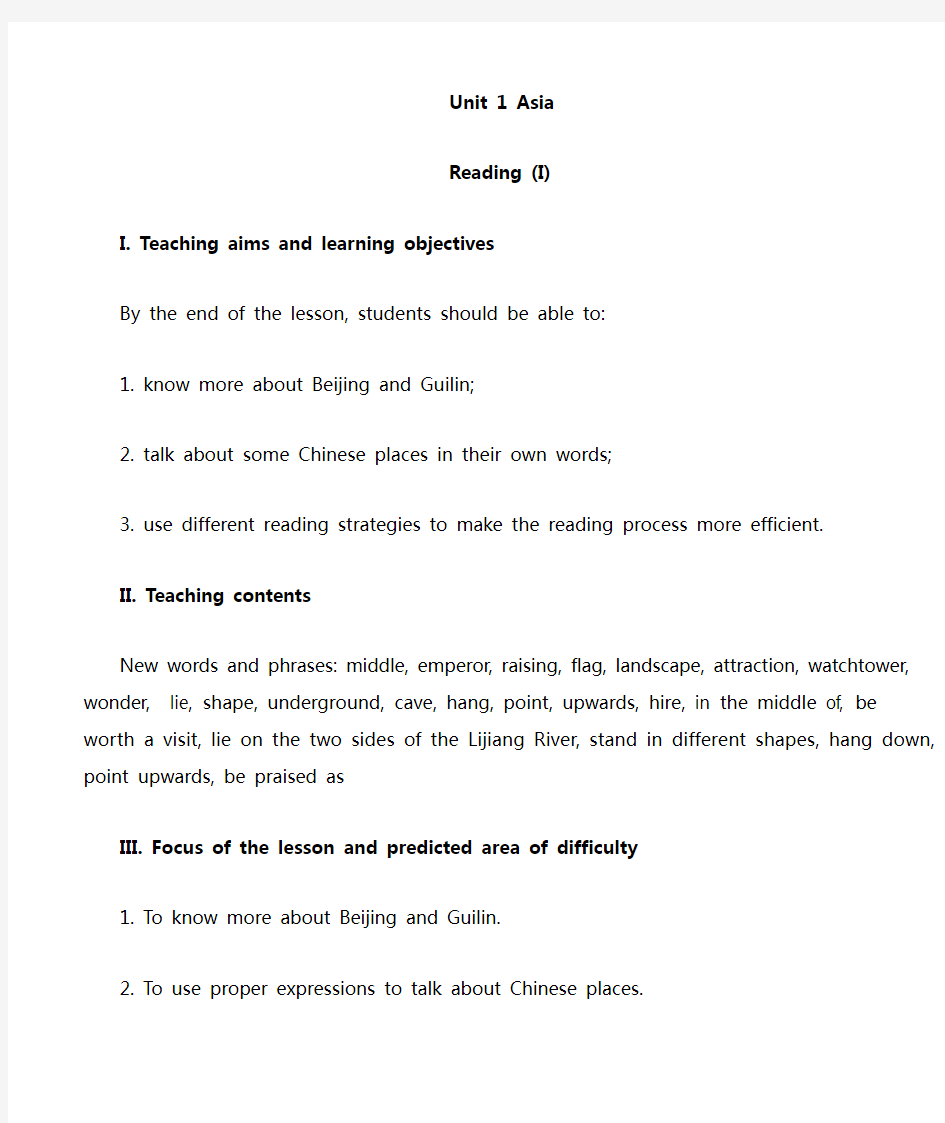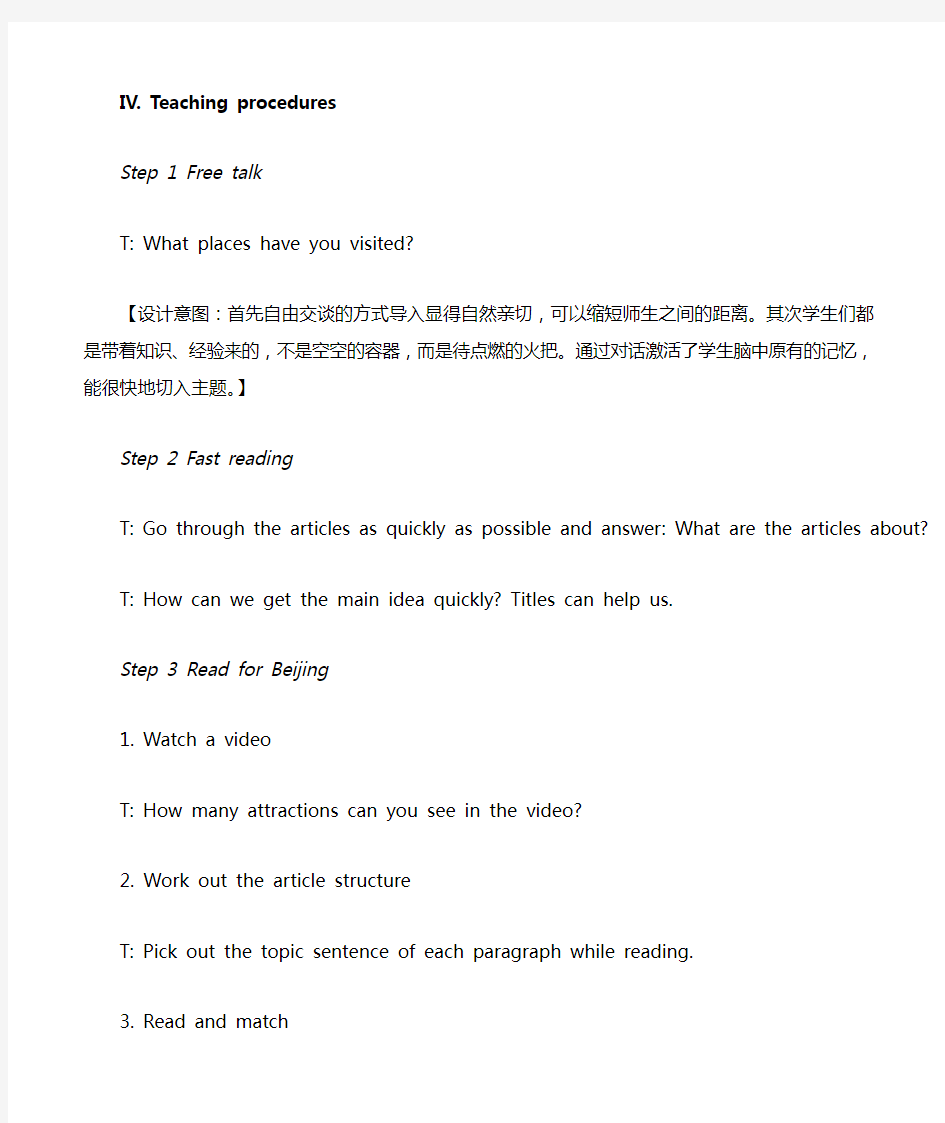

Unit 1 Asia
Reading (I)
I. Teaching aims and learning objectives
By the end of the lesson, students should be able to:
1. know more about Beijing and Guilin;
2. talk about some Chinese places in their own words;
3. use different reading strategies to make the reading process more efficient.
II. Teaching contents
New words and phrases: middle, emperor, raising, flag, landscape, attraction, watchtower, wonder, lie, shape, underground, cave, hang, point, upwards, hire, in the middle of, be worth a visit, lie on
the two sides of the Lijiang River, stand in different shapes, hang down, point upwards,
be praised as
III. Focus of the lesson and predicted area of difficulty
1. To know more about Beijing and Guilin.
2. To use proper expressions to talk about Chinese places.
IV. Teaching procedures
Step 1 Free talk
T: What places have you visited?
【设计意图:首先自由交谈的方式导入显得自然亲切,可以缩短师生之间的距离。其次学生们都是带着知识、经验来的,不是空空的容器,而是待点燃的火把。通过对话激活了学生脑中原有的记忆,能很快地切入主题。】
Step 2 Fast reading
T: Go through the articles as quickly as possible and answer: What are the articles about?
T: How can we get the main idea quickly? Titles can help us.
Step 3 Read for Beijing
1. Watch a video
T: How many attractions can you see in the video?
2. Work out the article structure
T: Pick out the topic sentence of each paragraph while reading.
3. Read and match
T: Pay attention to some key words, such as in the middle of, next to, in the north-west and across northern China, and the attractions can be easily found.
【设计意图:通过观看关于北京的视频,让学生初步了解各个景点,心生向往之情,产生阅读期待。阅读
过程中指导学生看标题获取文章大意,找主题句获取段落主旨并明晰文章结构,关注关键词获取各景点在北京的方位线索。通过这种方式,将阅读微技能策略指导落在实处。】
4. Close reading]
(1) The Palace Museum
T: First let’s read about the Palace Museum. While reading, ask yourself:
What is it also called?
Who used to live there?
Why is it worth a visit?
(2) Tian’anmen Square
T: Next to the Palace Museum is Tian’anmen Square.
Why is it so famous?
Why do tourists like to gather there early in the morning?
(3) The Summer Palace
T: Then how about the Summer Palace?
Is there anything special?
(4) The Great Wall]
T: Finally let’s talk about our Great Wall.
How long is it?
When was it first built?
Try to understand the two new words “watchtower” and “wonder”.
There’s a famous saying about the Great Wall: “He who has never been to the Great Wall is not a true man.”
【设计意图:鱼骨图是一种新的阅读方式,它脉络清晰,层次分明,通过逐渐添加获得的信息,将文章所有重要内容全部串起来,可帮助学生更好地获取文章细节。在分段读的过程中,在问题的引导下,利用流程图帮助学生理解,尽量做到图文并茂,吸引学生眼球,维持他们的阅读兴趣。部分生词通过构词法、图片或上下文在阅读过程中呈现,很好地与中考的阅读要求进行了对接。】
Step 4 Read for Guilin
1. Guess: What city is it?
T: Have you read the poem“江作青罗带,山如碧玉簪”? What city is it about? Please read the article and find
a saying about Guilin.
2. Make notes of Guilin
T: Kevin wants to make notes of Guilin. Help him complete them. Then try to understand the new words “shape” and “hire” according to the context.
3. Enjoy the beauty of Guilin
T: Guilin is so famous for natural beauty. Find sentences about its fantastic landscape.
Why do we say the Reed Flute Cave is amazing?
What about the rocks?
What is the cave praised as?
【设计意图:引用诗歌,以猜测入手,激发学生的阅读兴趣,通过完成笔记的练习很好地在学生脑中建构文章的脉络图,以探寻桂林山水之美为主线索,再次引领学生走进文本,读出了本篇文章所重点描写的景象。】
Step 5 Critical reading
T: We have learned a lot about the two cities. Which city do you like better, Beijing or Guilin? And why?
【设计意图:在学生学习了两篇文章后,依托文本开展审辩式阅读,学生要运用从文本中所获得的信息或者从脑中提取已有的知识。这是基于文本又高于文本的高级思维活动,经过比较、筛选,追寻最佳的选择。让学生在有理有据的情况下表达自己的观点,其核心意义在于让知识课堂演变为思维课堂。】
Step 6 Welcome to Suzhou
T: People often say there’s paradise in heaven and Suzhou and Hangzhou on earth. Would you like to be a guide and introduce Suzhou to Kevin?
【设计意图:在学生习得大量词汇后,跟进有意义的语言输出活动很有必要,这体现了“用中学、学中用”的原则。只有在输出过程中学生能运用自己的语言进行自如的表达,教学目标才真正达成。】
V. Homework
1. Read the two articles aloud.
2. Finish the notes of Suzhou.